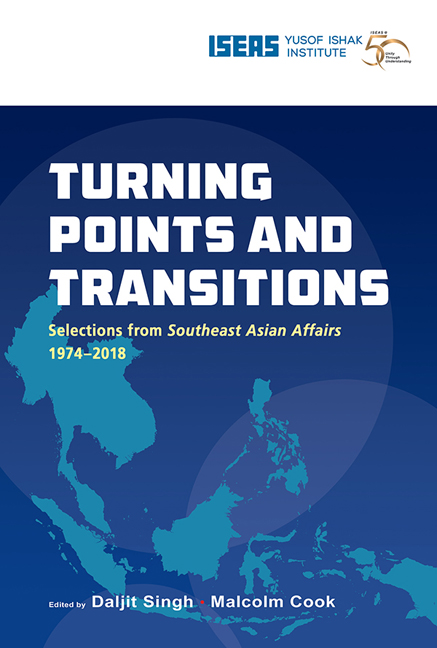Book contents
- Frontmatter
- Contents
- Message from the Director
- Foreword
- Foreword
- Introduction
- THE REGION
- BRUNEI
- CAMBODIA
- Cambodia and Regional Diplomacy (1982)
- Kampuchea 1979–81: National Rehabilitation in the Eye of an International Storm (1982)
- Cambodia 1991: Lasting Peace or Decent Interval? (1992)
- Hun Sen's Pre-emptive Coup: Causes and Consequences (1998)
- Cambodia in 2017: Plus ça change… (2018)
- INDONESIA
- LAOS
- MALAYSIA
- MYANMAR
- THE PHILIPPINES
- SINGAPORE
- THAILAND
- VIETNAM
Hun Sen's Pre-emptive Coup: Causes and Consequences (1998)
from CAMBODIA
Published online by Cambridge University Press: 29 May 2019
- Frontmatter
- Contents
- Message from the Director
- Foreword
- Foreword
- Introduction
- THE REGION
- BRUNEI
- CAMBODIA
- Cambodia and Regional Diplomacy (1982)
- Kampuchea 1979–81: National Rehabilitation in the Eye of an International Storm (1982)
- Cambodia 1991: Lasting Peace or Decent Interval? (1992)
- Hun Sen's Pre-emptive Coup: Causes and Consequences (1998)
- Cambodia in 2017: Plus ça change… (2018)
- INDONESIA
- LAOS
- MALAYSIA
- MYANMAR
- THE PHILIPPINES
- SINGAPORE
- THAILAND
- VIETNAM
Summary
On 5–6 July 1997, troops loyal to Second Prime Minister Hun Sen (of the Cambodian People's Party, or CPP) and those of First Prime Minister Norodom Ranariddh (leader of the royalist party known as FUNCINPEC, or the National United Front for an Independent, Neutral, Peaceful, and Co-operative Cambodia) engaged in a fierce street battle in Phnom Penh. The fighting stunned the Cambodian people and the world. Within two days, the CPP force defeated its enemy, and then pushed the remnants against the northern Thai- Cambodian border into a tiny strategic area called O Smach. At year's end, Hun Sen still held high the trophy of victory.
This article seeks to explore the events of July 1997. At issue is whether or not what took place constitutes a coup; and, if it is a coup, what kind? I argue that the overthrow of Ranariddh was a coup, not a social revolution or putsch. Unlike coups in many other countries, however, it was not caused by factors such as ethnic or ideological antagonisms, sociopolitical turmoil, or military dominance. I take a structural approach, arguing that Hun Sen's actions must be explained in terms of his struggle for hegemonic preservation, as his party and adversaries braced themselves for the next election scheduled for 1998. (In this study, the term “hegemon” means “leader”, and struggle for hegemony simply means struggle for political leadership.) Although the Second Prime Minister has now achieved political dominance, preventing bipolarity from emerging, he has also recreated Cambodia's old power structure, prone to coups, violence, and war.
Prelude to a Pre-Emptive Coup
In the debate over whether Hun Sen's actions were or were not a coup, those who supported or sympathized with the Second Prime Minister viewed them as preventing Prince Ranariddh from staging a coup against the government. Those who put the blame on Hun Sen considered his actions a coup. It may be worth describing politico-military developments leading to the July events and then examining the two opposing perspectives more closely.
In May 1993, elections were organized by the United Nations Transitional Authority in Cambodia (UNTAC), which intervened in the country following the Paris Agreement in October 1991.
- Type
- Chapter
- Information
- Turning Points and TransitionsSelections from Southeast Asian Affairs 1974-2018, pp. 244 - 259Publisher: ISEAS–Yusof Ishak InstitutePrint publication year: 2018

